Keeping your home secure and your family safe is crucial. Beyond locking doors and windows when no one’s around, there are other measures you can take to enhance security such as the many alarm systems available today.
In this DIY guide we will take a look at some of these, discover more below.
Enhancing Home Security
Feeling safe at home is essential, and taking steps to deter burglars can give you peace of mind. Here’s how to improve your home security:
- Deter Intruders: Install security lighting, CCTV cameras, and burglar alarms to discourage break-ins. Make your home look occupied even when you’re away.
- Control Access: Use secure door entry systems to screen visitors. Invest in high-quality mortise locks and sturdy security chains.
- Activate Alarms: A burglar alarm can scare off intruders attempting to enter your home.
- Document Incidents: Install CCTV cameras or recording devices to capture evidence of any incidents for the police.
Additionally, having an alarm system may lower your home insurance premiums, but remember to activate it to enjoy the benefits.
Types of Burglar Alarm Systems
Burglar alarms come with different detection methods and alert systems:
- Audio Alerts: Emit loud noises, bells, or bright lights to deter intruders.
- Security Center Notification: Inform a security center about the intrusion.
- Personal Notification: Alert you via SMS text on your mobile phone.
Some systems may combine these alert types for a more enhanced security system.
Bells-Only Alarms
Bells-only alarms activate loud alarm bells or a siren when a sensor detects activity, like a door opening or motion within the structure. However, their effectiveness relies on someone nearby hearing and responding to the alarm.
Notification Alarms
When activated, notification alarms can alert a monitoring centre, send an email or text message to designated contacts, or use speech diallers to call specified numbers until a response is received.
These systems employ various sensors or detectors for home security purposes:
Magnetic Contacts/Door Sensors
Magnetic contacts or sensors are installed on doors and windows, with one part attached to the fixed frame and the other to the opening section.
When closed, they complete a circuit. If the door or window is opened while the system is armed, breaking the circuit, the alarm is triggered.
These sensors come in various types and styles, from those integrated into a central system to standalone units securing individual windows or doors.
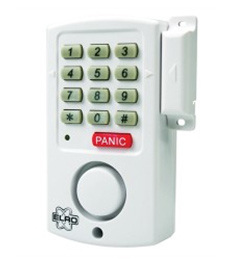
Magnetic catch door or window alarm
Interior Motion Detectors (PIR’s etc.)
While technically distinct, Passive Infrared Detectors (PIRs), Motion Sensors, and Infrared Sensors operate similarly. They detect movement or body heat within a defined area and trigger an alarm, such as the one depicted below. These sensors connect to a central alarm system.
They are the most common type of sensor in burglar alarms, available in both hard-wired and wireless configurations. Many modern models are pet-friendly to prevent false alarms from pets.
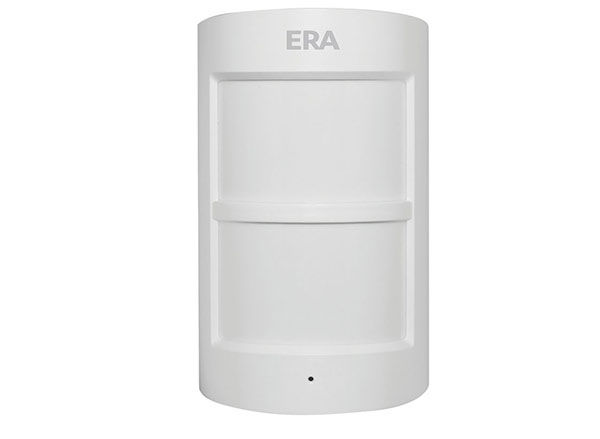
PIR motion detecting sensor
Glass Break Sensors
These sensors detect when a window pane is shattered, signalling a potential break-in.
Attached to glass, they detect vibrations. If they sense a strong enough vibration, indicating glass breakage, they activate the alarm.
While typically found in large industrial properties, they’re also available for high-end residential systems. Individual sensors can be placed on specific windows.
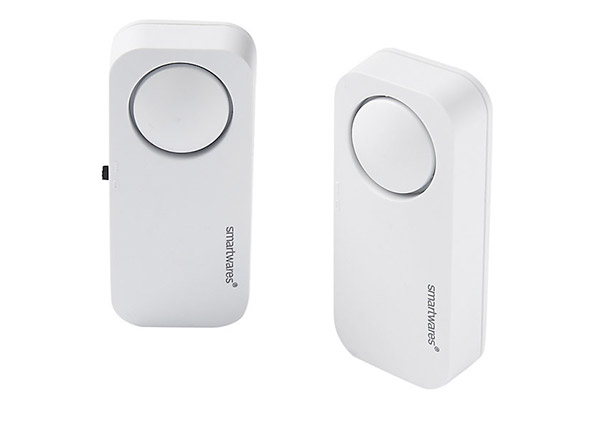
Glass break sensor for an individual window
DIY Alarm Systems
For those comfortable with DIY projects, self-install security systems offer a budget-friendly option.
These kits come in wired or wireless options, with wireless being easier to install. Both offer upgrades like extra sensors, cameras, remote controls and a whole host of other goodies.
Kits are available with bells-only alarms or notifications, often requiring subscriptions to monitoring services.
Setting up notification systems may involve configuring apps, SIM cards, or Wi-Fi connections, so a little tech knowledge and following instructions is crucial.
However, some monitoring services require professional installation.
Both types allow for personalisation with a PIN, accessible via a keypad or mobile app.
One standout option is the SimpliSafe DIY system, a modular Wi-Fi system that’s easy to set up and expand. Starting at under £200, it offers additional sensors, cameras, and monitoring services.
It’s compatible with smart devices like Apple Watches, Alexa, and Google Assistant for convenient control.
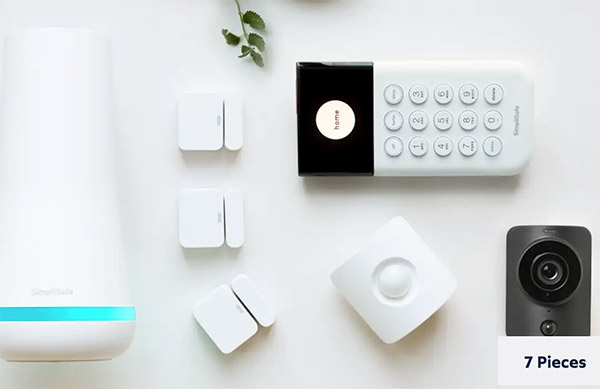
The base level Essentials SimpliSafe alarm system
Monitored Alarm Systems
With monitored alarms, you can trust that if they go off, someone will respond. Unlike standalone alarms, which may be ignored, monitored ones connect to a 24-hour security centre.
A professional recommended or employed by the security company installs these systems. While options like SimpliSafe offer monitoring, dedicated monitored alarm systems typically have in-house monitoring by dedicated staff.
This service usually comes with a monthly cost, depending on the level of service you choose. Local and national brands like ADT and Verisure offer these services, with Verisure’s wireless system allowing easy expansion and control via a smartphone app.
Many of these systems include fire and heat alarms for added safety. Maintenance contracts, often included in the fee, cover remote error checking and on-site repairs.
Various security cover levels are available with these premium services.
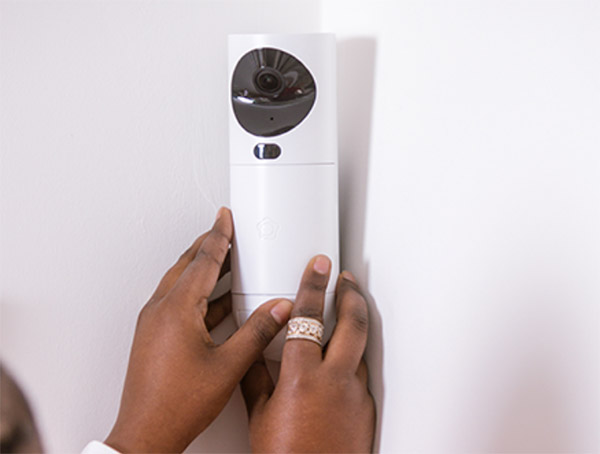
The Verisure Orion video camera
Keyholder Monitoring
This service, provided by monitoring companies, varies based on your subscription level. If the alarm triggers, they may dispatch their security officers or contact your designated key-holder.
Your key-holder must be reachable within a 20-30 minute drive and possess keys for access. It’s your responsibility to update the monitoring company with their details and provide spare keys if you change locks.
Companies like ADT and Securitas typically offer this service, more common for businesses and industrial properties.
Police Monitoring
This service alerts both your monitoring company and the local police station. Typically, two sensors must be triggered for police response.
However, it’s crucial to note that police may not always respond promptly, and excessive false alarms could result in removal from their response list.
While beneficial, this service often comes at an additional cost and requires the monitoring company’s registration with your local police station.
Fire Monitoring
Similar to police response, fire monitoring alerts authorities in case of fire detection. Verification through visual or detector confirmation is essential before any dispatch takes place.
As with police systems, excessive false alarms may lead to removal from the response list.
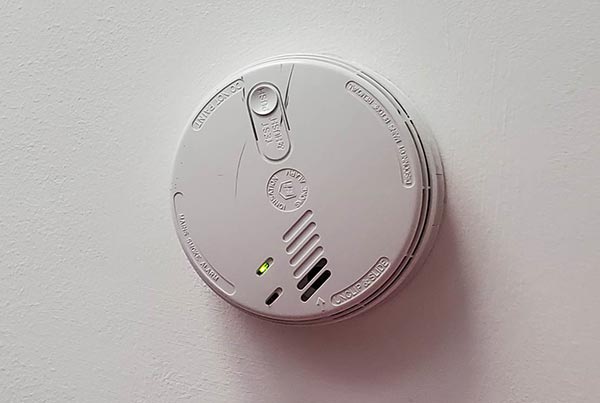
Smoke alarm connected to alarm system
Cost of Burglar Alarm or Security System Installation
Single magnetic alarms for windows and doors cost about £15 each, safeguarding only the specific window or door.
Diverse DIY security systems range from approximately £180 to over £1400.
With recent technological advancements, DIY systems now effectively secure homes or buildings.
Monitored security system costs vary widely. Installation ranges from £180 plus an additional £125 for installation (SimpliSafe) to £1400, with monthly monitoring starting at £15, mid-range around £30, and premium options nearing £100.
Cost reflects system components and monitoring comprehensiveness, with lower-cost options typically providing only the basic components and limited, if any, monitoring services.
GSM Alarms Explained
GSM stands for Global System for Mobile communications, meaning it operates using a SIM card, like a mobile phone, rather than a traditional phone line. This makes it wireless, like the SimpliSafe system mentioned earlier.
Modern GSM alarms allow you to control your security system using your mobile phone or tablet via a simple app.
These systems offer various options, including temperature detectors for fire prevention, flood detectors, indoor and outdoor cameras, and more.
When a sensor is activated, the system can send notifications to your app and, if you have a monitoring contract, to a control centre as well.
CCTV Systems Explained
CCTV stands for Close Circuit Television. Installing a CCTV system on your property is perfectly legal, but check if you need planning permission.
These systems are the original type of security setup. They consist of cameras positioned to monitor both inside and outside a building. The cameras capture images, which are then sent to a central control unit.
The control unit records footage from each camera, allowing you to watch live or playback recordings if needed.
Modern CCTV systems often offer remote viewing capabilities over the internet through a web browser or app.
When positioning cameras, ensure they only cover your property, not your neighbours, unless you have their permission.
Be cautious about camera placement to avoid potential legal issues, such as harassment or violating The Human Rights Act, by inadvertently capturing areas beyond your property boundaries.
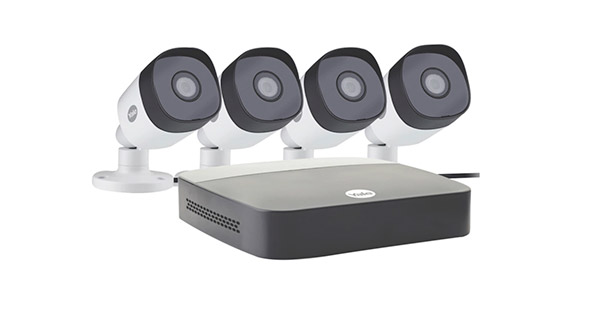
Yale wired CCTV security system
Panic Buttons: Quick Safety Solutions
Panic Buttons offer peace of mind, especially for the elderly and vulnerable. When pressed, they immediately raise an alarm.
These buttons come in various forms: wall-mounted, integrated with intruder alarms, or as part of a wearable pendant. Upon activation, they can dial programmed contacts and notify a security centre.
Given their effectiveness, most system suppliers like ADT, Yale, Simplisafe, and Verisure now offer panic button features as part of their systems.

Verisure security system panic button
Dummy Burglar Alarm Box: Limited Deterrent
Installing a dummy alarm box outside your house might discourage casual burglars, but experienced thieves can easily spot the difference between a real system and a fake box.
However, these dummy boxes are not very effective and won’t lower your insurance premiums. Investing in stronger locks for doors and windows is a more practical way to enhance home security.
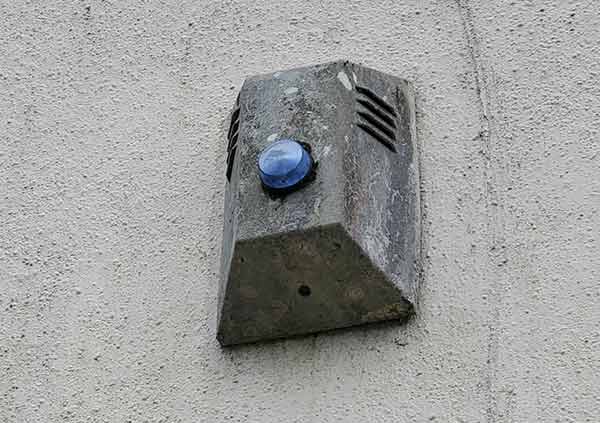
Old dummy alarm box on the side of a property
Identifying Vulnerable Areas for Home Security
Every home has its weak spots, and it’s crucial to identify and cover them with cameras or sensors for complete security.
Homes with large gardens often have poorly lit areas around ground floor windows, making them easy targets for intruders. Adding PIR security lights, a burglar alarm, and security cameras can enhance security.
In second floor flats, the hallway near the entry door is the primary vulnerable area. Installing a door entry system with a video link can provide effective security.
For terrace houses with elongated layouts, detectors at the front and back doors are beneficial. These can include magnetic contacts on doors or wall-mounted PIR sensors.
Typically, the front door is the most common entry/exit point in most homes. Therefore, positioning the control panel near the front door allows easy arming and disarming of the system upon entering or leaving the house.
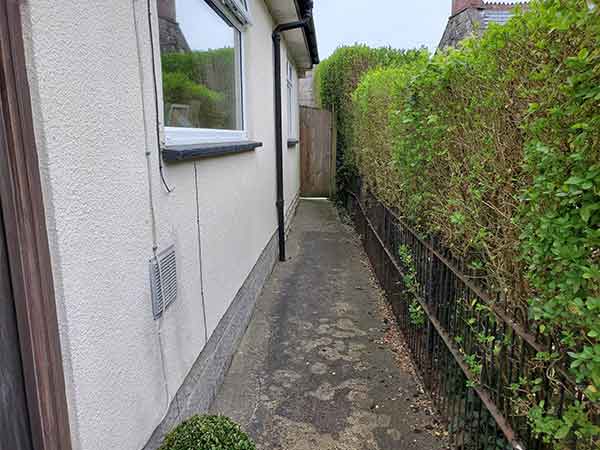
Pathway with very little lighting at night
Enhancing Security with Outdoor Lighting
Outdoor lighting is an affordable and effective method to safeguard your property from vandalism and burglary. Intruders prefer darkness, so lighting acts as a deterrent.
Types of outdoor security lighting include:
PIR Motion Sensor Lighting
PIR (Passive Infrared Sensor) motion sensor lighting activates when someone enters its detection area. The light remains on for a specified duration and switches off when there’s no further movement, until triggered again.
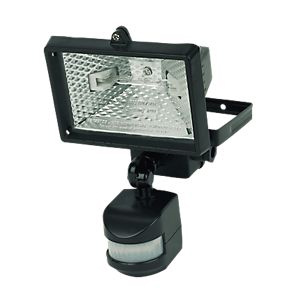
Halogen PIR security light
Dusk-to-Dawn Security Lighting
Dusk-to-dawn lighting offers continuous illumination throughout the night. It’s either timed to turn on at dusk or triggered by a light sensor. While it doesn’t detect movement, it serves as a deterrent to potential intruders.
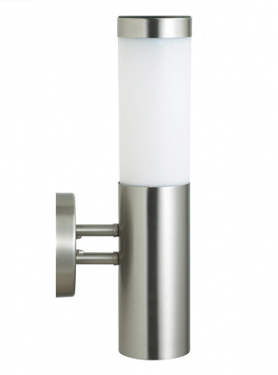
Dusk-to-dawn outside light
Hi-Lo Security Lighting
Hi-Lo lighting automatically activates at dusk via a light sensor. It emits a softer light initially, but brightens if motion or body heat is detected nearby. This system combines the benefits of both dusk-to-dawn and motion sensor lighting.
When installing security lighting, remember to cover back doors and side alleys.
While it’s handy to have motion sensor lights for finding keys, their primary function is to deter potential burglars. Stand outside your home in the dark to identify areas that could benefit from additional security lighting.
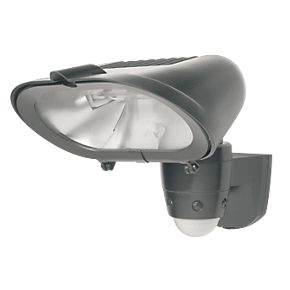
Hi-lo outdoor security light with PIR sensor
Solar and LED Energy Saving Options
Most affordable security lights use traditional bulbs, like Halogen or standard bayonet/screw-in types. However, leaving these lights on for extended periods can rack up energy costs.
Today, LED lights dominate the market, despite being pricier upfront. They’re a smart investment due to significant long-term energy savings.
Comparatively, a 20W LED light consumes 90% less energy than a 400W traditional light.
In addition to LEDs, many outdoor lights are available in solar-powered versions, making them easy to install anywhere without the need for mains connection and running completely on free solar energy!
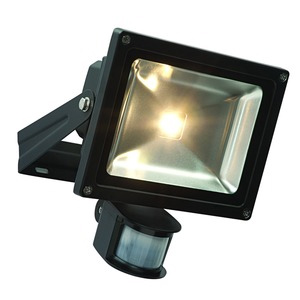
LED security floodlight with PIR
Security systems used to be pricey and complex, but today’s options are much more affordable and user-friendly. Even those on a tight budget can consider them. With simple setup and advanced technology, modern home security systems are accessible to anyone looking to protect their property.

